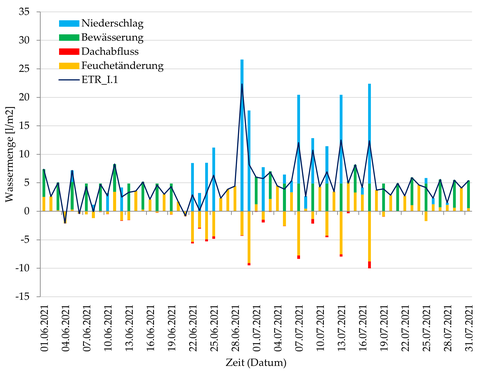Master Thesis Lebedev
Practically measured air change rates in buildings based on a literature study covering publications since 2011
Praktisch gemessene Luftwechselraten in Gebäuden basierend auf einer Litera-turstudie, die Veröffentlichungen seit 2011 umfasst

Evapotranspirationsbilanz im Feld 1
The natural air exchange in indoor spaces is crucial for the health and well-being of the occupants. It is the sum of the infiltration exchange, i.e. the exchange of air through joints and other leakages in the building envelope, and the active air exchange through win-dows, doors, and openings. There are currently two ways to measure this air exchange. Firstly, it can be determined using the pressure difference method (blower door test) and secondly using the indicator gas method (tracer gas method). In the first case, a negative or positive pressure method can be implemented and the determined air exchange rate represents a good energetic comparative characteristic value for façades among each other. On the other hand, this measurement method is unsuitable for recording realistic air changes that would occur under conditions of use. The second method with indicator gases is more complex than the pressure difference method but yields representative char-acteristic values for the air change. These can be used to extrapolate the measured values to the year if the building characteristics (type of leakage, type of window and door joints, distribution of joints, etc.), the conditions of use (e.g. time-dependent use density), and the climatic conditions (indoor air temperature, indoor air humidity, outdoor air temper-ature, outdoor air humidity, wind speed, wind direction, etc.) are known at the same time.
Within the scope of the work, the most relevant measurements of air exchange rates in residential and non-residential buildings published internationally since 2011 are to be compiled. For the interpretation of these data, the measurement methods (pressure differ-ence or indicator gas method), the measurement conditions (indoor and outdoor climate), and the building characteristics (properties of the building envelope, especially tightness and usage characteristics) are to be explained. Special attention should be paid to the pub-lications on the direct comparison of both measurement methods. Furthermore, refer-enced guidelines for the examined measurements are to be listed if mentioned. The result is three table overviews with the results of the measurements for the pressure difference method (Table 1, including method-specific data such as pressure level, underpressure or overpressure, special features), the measurements for the indicator gas method (Table 2, also with the method data and the above-mentioned measurement conditions) as well as an overview of the published comparative measurements of both methods (Table 3). From these overviews, with a focus on Table 3, a conclusion can be drawn regarding the suitability and the boundary conditions to be respected for the methods.
Work Steps
- Literature study on the air change measurements in occupied buildings including guidelines, standard literature (books), etc., result: description of the measurement and calculation procedure for each approach
- Literature study on applied pressure difference resp. blower door method in residen-tial and non-residential buildings (international articles since January 2011), result: ta-ble overview with references, procedure, and case specifications (table 1)
- Literature study on applied tracer gas resp. indicator gas measurement in residential and non-residential buildings (international articles since January 2011), result: table overview with references, procedure, and case specifications (table 2)
- Literature study on comparative measurements with both, pressure difference and tracer gas measurement, in residential and non-residential buildings (international articles since January 2011), result: table overview with references, procedure, and case specifications (table 3)
- Interpretation of the tables regarding the suitability and boundary conditions of these measurements
Supervisor
Cooperative supervision with Dipl.-Ing. Heiko Fechner.
 © Dr. Ing. Peggy Freudenberg
© Dr. Ing. Peggy Freudenberg
Chair Representative
NameDr.-Ing. Peggy Freudenberg
Send encrypted email via the SecureMail portal (for TUD external users only).
